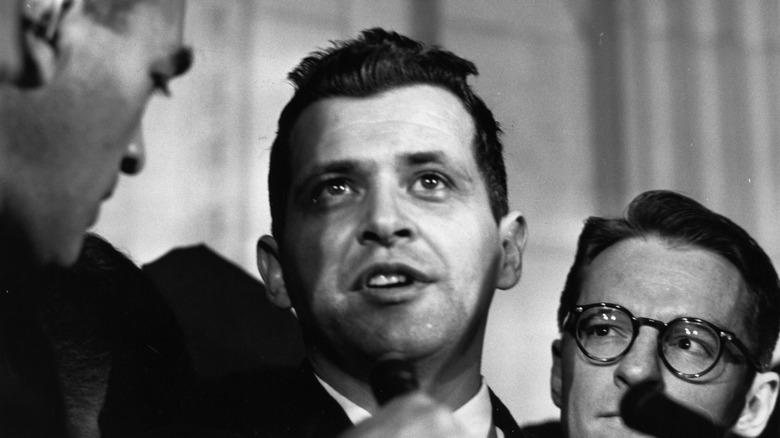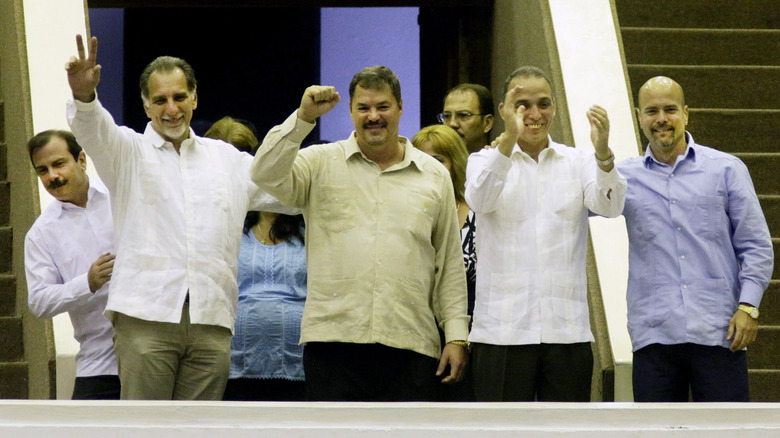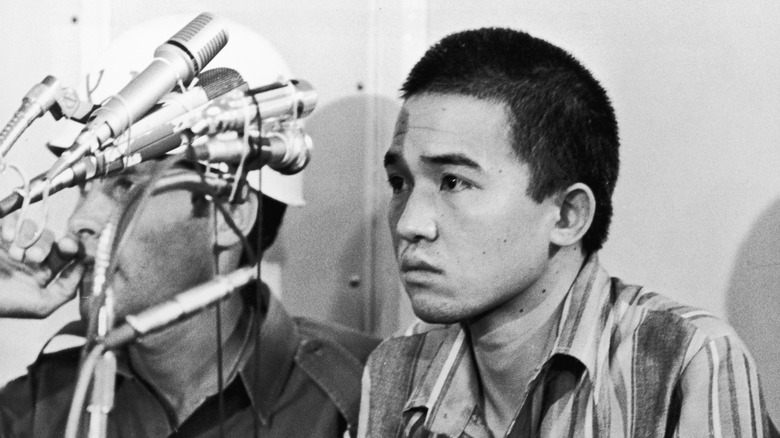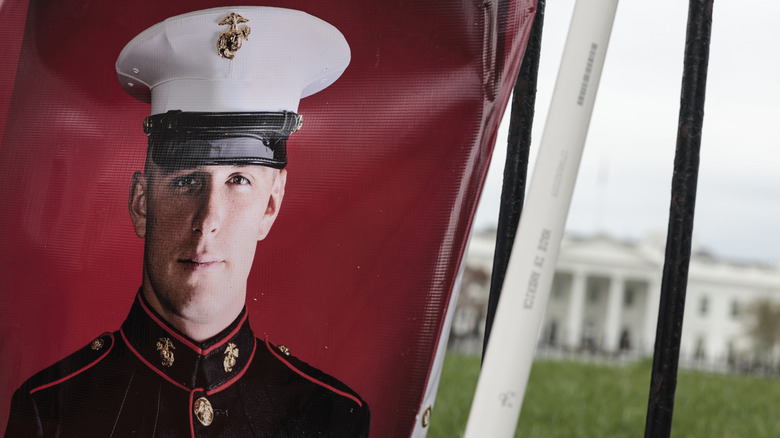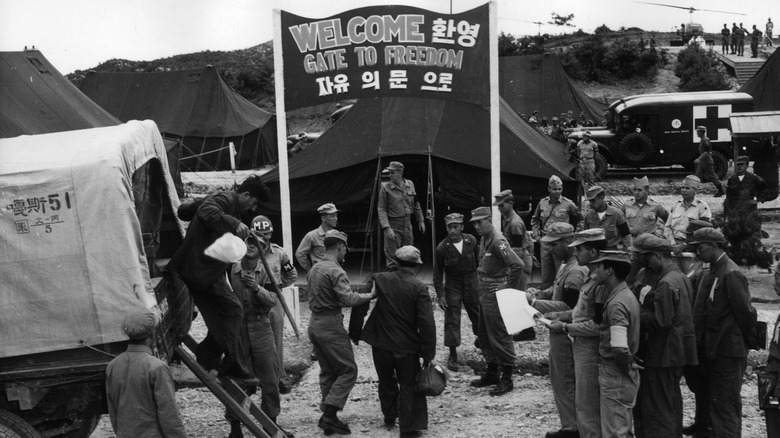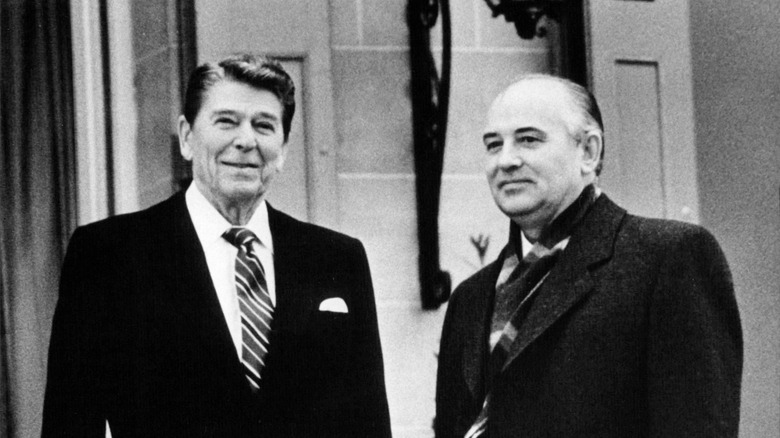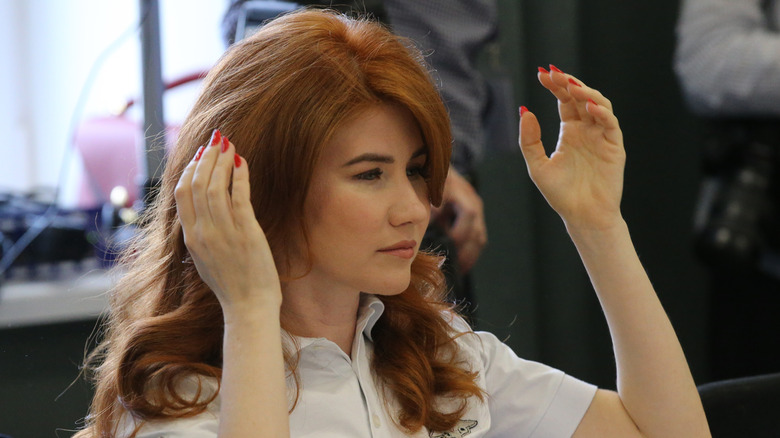The Most Famous Prisoner Exchanges In History
Sometimes, the relationship between two countries becomes strained when one of them imprisons citizens of the other. However, because there are many countries and many reasons to be imprisoned, this is rarely a one-way street. In cases where two or more countries have imprisoned each other's citizens, and deem said citizens important enough, they might start to discuss prisoner swaps. As the Economist notes, these are individually reviewed and decided deals that tend to revolve around espionage or detainees who draw public attention, though prisoner exchanges have also been known to happen during times of war (via Deutsche Welle).
In 2022, the concept of prisoner swaps once again made headlines in the U.S. because of basketball star Brittney Griner, who received a 9-year prison sentence in Russia after she was arrested in the country for having a small amount of cannabis oil in her luggage. However, this is hardly the first time such deals have been considered — after all, history is full of dramatic and difficult prisoner exchanges. Let's take a look at some of the most famous cases.
The 1960 Bridge of Spies exchange
Film buffs might be familiar with "Bridge of Spies," Steven Spielberg's 2015 espionage thriller about a particularly difficult cold war-era prisoner exchange between the U.S. and the Soviet Union. As Biography tells us, the movie is very much based on a true story. In 1957, the U.S. captured a Soviet spy known as Rudolf Abel. Per The Washington Post, Abel's lawyer, James Donovan, successfully suggested that the spy wouldn't be sentenced to death, because he could be a useful bargaining piece in a potential prisoner swap at some point down the line.
In 1960, American pilot Francis Gary Powers was shot down and caught while flying a U-2 espionage plane within the borders of the Soviet Union (via Britannica). His arrest made Donovan's prisoner exchange idea a genuine possibility, and the lawyer soon found himself on an adventure of a lifetime. U.S. authorities recruited him on a secret and unofficial mission to negotiate the prisoner swap under the radar. After accepting, Donovan traveled to Germany and made many arduous and dangerous visits to East Berlin to achieve his mission. In the end, he managed to negotiate the release of Powers and another American prisoner, Frederick Pryor, in exchange for Abel.
Powers and Abel were finally exchanged in an appropriately tense and cinematic manner on February 10, 1962. Representatives of the countries met on the Glienecke Bridge between East and West Berlin, facing each other until Pryor's release in another location was confirmed.
The Cuban Five prisoner exchange
What with the Cuban missile crisis and the embargo on Cuba, The U.S. and Cuba aren't historically the greatest of friends. However, they're still on talking terms when needs must, as the 2014 prisoner exchange between them proved (via NPR). The case revolved around the Cuban Five (via The Washington Post), a group of Cuban spies who were caught in Miami, Florida, in 1998, and received lengthy prison sentences in 2001.
The Cuban Five are esteemed in their home country, and in late 2014, three of them were still in prison. However, Cuba also had a prisoner that was important to the U.S., which led the countries to set up a spy swap. Who was so important that the U.S. was willing to exchange these Cuban national heroes? Why, just the super-agent that helped catch the Cuban Five in the first place, according to President Barack Obama. "This man, whose sacrifice has been known to only a few, provided America with the information that allowed us to arrest the network of Cuban agents that included the men transferred to Cuba today, as well as other spies in the United States," Obama described the unnamed agent. "This man is now safely on our shores."
Per Reuters, the agent had already been in Cuba's custody for 20 years, so the exchange was clearly a long time coming. Since Cuba's President Raul Castro also praised the spy swap, it appears that the result managed to please both countries.
The Jibril Agreement and other Israeli-Palestine prisoner swaps
The Israeli-Palestinian conflict has been going on since Israel's official creation in 1948, and tensions in the area have been high well before that, according to the BBC. Over this time, there have been a number of prisoner exchanges, per Al Jazeera — and some of them have been so big that they dwarf most other prisoner swaps discussed in this article.
Perhaps the most high-profile one of these exchanges is known as the Jibril Agreement, which took place in 1985 and, As Haaretz tells us, was named after the leader of the Popular Front for the Liberation of Palestine-General Command, Ahmed Jibril. In this exchange, Israel swapped no less than 1,150 prisoners for three imprisoned Israeli soldiers. Per The Washington Post, among the 1,150 prisoners Israel exchanged for its soldiers was a member of the Japanese Red Army called Kozo Okamoto (pictured). He was the only surviving terrorist behind the deadly 1972 terror attack at the Tel Aviv airport (via France 24), which killed 26 people and wounded over 70 (per the BBC).
As great as the scale of the Jibril Agreement was, it's not even the biggest prisoner exchange in Israel's history. In 1983, the Palestine Liberation Organization and Israel arranged a swap of six Israeli soldiers for over 4,500 Palestinian prisoners.
Trevor Reed prisoner exchange
One of the more recent high-profile prisoner exchanges took place in 2022, according to CNBC. The case revolved around a former U.S. Marine called Trevor Reed, per NPR. In 2019, Reed was arrested in Russia for allegedly assaulting local authorities, and had been imprisoned ever since. However, his family ran a constant campaign for his release, and increasing attention led to a prisoner exchange.
The exchange took place on April 27, 2022 — in other words, during a time when the U.S.-Russia relationships were particularly strained due to Russia's invasion of Ukraine. While the exact details have not been released, it's known that the U.S. government swapped Reed for a Russian man called Konstantin Yaroshenko, who was serving a 20-year sentence in the U.S. for his involvement in drug smuggling.
President Joe Biden sanctioned the move (via the White House) and made clear in his statement that the release process was far from easy. However, he also promised that the work to pull off similar prisoner exchanges with Russia remained underway. Biden mentioned another U.S. Marine veteran, Paul Whelan (via CNN), in particular. "The negotiations that allowed us to bring Trevor home required difficult decisions that I do not take lightly," the statement read. "His safe return is a testament to the priority my Administration places on bringing home Americans held hostage and wrongfully detained abroad. We won't stop until Paul Whelan and others join Trevor in the loving arms of family and friends. "
Operations Big Switch and Little Switch
Operations Little Switch and Big Switch were major Korean War prisoner exchanges (via Time). The U.S. entered the Korean War in 1950 as the spearhead of the United Nations Command, and by the time the war ended in 1953 (via Encyclopedia Britannica), many had been captured. To deal with this, U.S. General Mark W. Clark had a meeting with his Chinese counterpart and North Korea's Kim Il Sung to set up a prisoner exchange operation called Little Switch (per Air Force Medical Service).
Little Switch started on April 20, and for the next 13 days, thousands of injured or otherwise indisposed prisoners were swapped. The United Nations forces gave back a total of 6,224 prisoners and received at least 684 of their own in return.
Come August, a grander phase started when Big Switch kicked in. Though the numbers involved were much bigger — the U.N. forces released over 75,000 prisoners and received nearly 13,000 — the mood was lighter than during Little Switch because the Big Switch prisoners were in better shape and had time to mentally prepare for freedom. "These boys are more alive," an American doctor commented. "They laugh more. They seem more aware of everything that is going on around them."
Meanwhile, the communists reportedly used the swap's propaganda possibilities to their full extent. They tore their uniforms and even rolled on the ground to make themselves look disheveled and badly treated for the cameras.
The 1985 Glienicke Bridge spy swap
The "Bridge of Spies" exchange of Soviet spy Rudolf Abel and American pilot Francis Gary Powers in 1962 (via The Washington Post) might be the best-known prisoner swap involving the Glienicke Bridge, but it's not the only one. Per The New York Times, the bridge that connected East and West Berlin saw an even bigger and more espionage-heavy exchange in 1985.
On June 12, 1985, a large prisoner swap took place on the bridge. Eastern Bloc authorities released 23 Western prisoners who'd been incarcerated in Poland and East Germany, along with two more who wished to stay behind the Iron Curtain for their own reasons. None were American, but the U.S. was still heavily involved in the exchange, as the four prisoners the West released were all incarcerated in U.S. prisons. These four hailed from East Germany, Poland, and Bulgaria, and were either involved or allegedly involved in espionage. They seem to have been of some importance, seeing as the suggestion for the swap came from East Germany, and it was reportedly overseen by Wolfgang Vogel, who also worked on the Abel-Powers exchange in 1962.
The 25 people the West received in the exchange were all reported to be agents, too. Perhaps because of this, their identities were not disclosed to the public. However, one of them — a man who called himself Gerhard Suss – gave an interview after being released, stating that he'd been subjected to regular torture during his 13-year imprisonment.
The Daniloff-Zakharov swap of 1986
On August 30, 1986, Nicholas S. Daniloff was arrested on suspicion of espionage in Moscow, per the Associated Press. He worked for the U.S. News & World Report magazine in Moscow, and the KGB took him after he allegedly received some classified information from a local. However, U.S. authorities immediately called foul because they felt that the arrest was an act of revenge for Gennadiy Zakharov, a Soviet citizen who'd been arrested for alleged spying in the U.S. a week before. As The Washington Post tells us, Daniloff himself was adamant that he was no spy.
Adding to the uncomfortable situation was the fact that the arrests happened during a particularly precarious political time between the two countries. The U.S. and the Soviet Union were negotiating the future of their vast arsenals, and President Ronald Reagan and General Secretary Mikhail Gorbachev were about to have a high-stakes meeting in Reykjavik, Iceland. The Daniloff situation soon bled into the world leaders' talks and threatened to cast a shadow over the meeting itself. Soon enough, the possibility of defusing the situation with a Daniloff-Zakharov swap came up.
According to The Los Angeles Times, Daniloff initially disagreed with the exchange, since he didn't feel great about being involved in a spy exchange because he wasn't one himself. Nevertheless, the news of the swap emerged on October 1 (via The Los Angeles Times). Along with Daniloff, the U.S. also managed to secure the release of Soviet dissident Yuri Orlov.
The Bowe Bergdahl exchange
In 2009, Bowe Bergdahl disappeared from his post at the Observation Post Mest in Afghanistan, as Military.com tells us. He was captured by the Taliban and spent no less than five years as their prisoner. As The Washington Post notes, his disappearance soon became a massively complex case, for a number of reasons.
Bergdahl's captivity attracted considerable attention because his parents campaigned for his release non-stop, and also because he was the first and only U.S. soldier captured by the enemy during this particular campaign. The military arranged a huge, thousands-strong operation to recover him, and Washington took a keen interest in the case. Bergdahl was ultimately released in 2014 in exchange for no less than five Guantanamo Bay prisoners, and to add insult to injury, the Taliban released video footage of the supposedly secret prisoner exchange process (via The Guardian).
The freshly liberated Bergdahl was initially welcomed with open arms (per Military.com), but the tide of public opinion soon changed against him. The reason the Taliban caught Bergdahl in the first place was that he abandoned his post and left his unit on July 30, 2009, which earned him plenty of disparaging comments. Perhaps most notably, Donald Trump spoke ill of him multiple times during his 2016 Presidential campaign. As CNN notes, some of Bergdahl's unit members from Afghanistan weren't much kinder. In 2017, Bergdahl pled guilty to desertion and misbehavior before the enemy and was subsequently dishonorably discharged.
The 2010 U.S.-Russia prisoner swap
As fans of FX spy drama "The Americans" may know, the show is based on a true story (per Quartz). On June 27, 2010, the FBI's long-running Operation Ghost Stories led to the arrests of 10 Russian operatives. According to the BBC, in July, they were sent to Russia as part of a prisoner exchange.
The bulk of the exchange took place in an airport in Vienna, Austria. The U.S. swapped the 10 agents for four prisoners — including nuclear researcher Igor Sutyagin, who spent 11 years behind bars for spying and was caught completely unaware by the news of his release (per The Guardian). Sutyagin has maintained that he dealt in open source data instead of classified information, and has suggested that Russia's FSB security agency set him up to avoid budget cuts. "Specialists always want to prove their value," he said. "It's hard to be a counter-intelligence officer and never catch a spy."
The best-known name involved in the exchange was Russian agent Anna Chapman (pictured), who reportedly came very close to seducing a high-ranking U.S. official during his time in the country (per Business Insider). As The Guardian has noted, however, this story couldn't be further from the truth, and was based on media misrepresentations of a senior FBI official's interview. Still, Chapman went on to become a celebrity in Russia, making a name for herself as a fashion designer, and even getting her own TV show (via The Guardian).
Xiyue Wang prisoner exchange
In August 2016, American citizen and Princeton grad student Xiyue Wang was arrested in Iran and received a 10-year prison sentence for espionage activity, per The New York Times. Wang was in the country to study the Farsi language, and according to NPR, he's insisted that he was no spy. What's more, he says that the people who arrested him were fully aware of that fact. While Wang had to go through some interrogations, he said that the Iranians didn't much care about anything he had to say ... beyond getting him to confess that he was a spy, that is. Wang even said that his captors were perfectly open about the fact that he was merely a pawn to be used in the grander scheme of things.
"They told me quite explicitly just that 'we need a deal with America'," Wang said. "They were very straightforward about that. They said, 'We want our money back from the United States. We want our detainees back, and you have to be a spy in order for that to happen.'"
After over three years in the Evin Prison in Tehran, Wang was released on December 7, 2019, after representatives of Iran and the U.S. negotiated a prisoner exchange between him and a scientist called Massoud Soleimani, whom the U.S. had incarcerated for trade violations. The U.S. apparently ended up getting a pretty good deal, since Soleimani could reportedly have been released from prison in a month or so.
Brittney Griner
The high-profile saga started, says ESPN, with WNBA star Brittney Griner's arrest in Moscow. Convicted on drug charges stemming from vape cartridges and cannabis oil, Griner was sentenced to nine years in a Russian prison.
The New York Times says that what led to the exchange was almost insanely complicated, and involved scores of people — many operating from the shadows — and several other countries, including Germany. Originally, Russia offered to trade Griner for an arms dealer named Viktor Bout. Bout was being held in an American prison on a 25-year sentence, but the problem was that there was another American the U.S. was also trying to trade for. That was Paul Whelan, a former Marine convicted of being a spy. (The U.S. government has denied this.)
Russia was determined to trade what they saw as a criminal for a criminal, i.e. Bout for Griner. However, Whelan was convicted of being a spy, so Russia insisted on getting a spy in trade ... which ultimately led to Whelan's freedom being taken off the table.
Even once it was decided to swap Bout for Griner, logistics were difficult: With most European nations — even the traditionally neutral Switzerland — standing together in opposition to Russia's invasion of Ukraine, finding a place where both parties could go was a challenge. The location became the United Arab Emirates' capital of Abu Dhabi, and the December 2022 transfer was celebrated by President Joe Biden and Griner's wife, Cherelle Griner, from the Oval Office.

